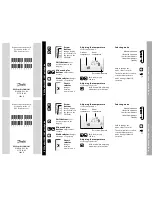
3
TEST START
The motor can be started manually by pressing the run test button.
METHODS OF STOPPING
MANUAL STOP
Manual stop is done by pressing the priority STOP push button. Note that pressing the stop push button will prevent the
motor from restarting as long as the button is pressed, plus a two second delay.
AUTOMATIC STOP
Automatic stop is possible only after an automatic start and this function has been activated. When this function is
enabled, the motor is automatically stopped 10 minutes after the restoration of the pressure (above the cut-out threshold)
given that no other run cause is present.
FLOW STOP, HIGH ZONE STOP
If the controller has been started by the FLOW/ZONE START/STOP input and the signal has returned to normal, the motor will
be stopped given that no other run cause is present.
EMERGENCY STOP
The emergency stop is always possible in any starting condition and is done by using the main disconnecting means
located on the door.
The Mark III medium voltage electric fire pump controller is cULus listed, FM certified and is intended to be installed in
accordance with the latest edition of the Standard of the National Fire Protection Association for the Installation of
Centrifugal Fire Pumps, NFPA20 2016 (Centrifugal Fire Pumps) and
in the USA, National Electrical Code NFPA 70
others * Local Electrical Codes *
*Only American applicable codes have been considered during the design of the controllers and the selection of
components.
Except, in some cases, the controller is also seismic approved and has been tested in accordance with the ICC-ES AC156,
IBC 2015, CBC 2016, OSHPD Special Seismic Certification Preapproval – OSP and ASCE 7-10 Chapter 13 standards. Proper
installation, anchoring and mounting is required to validate this compliance report. Refer to this manual and drawings to
determine the seismic mounting requirements and location of the center of gravity (you may need to contact factory). The
equipment manufacturer is not responsible for the specification and performance of anchorage systems. The structural
engineer of record on the project shall be responsible for anchorage details. The equipment installation contractor shall be
responsible for ensuring the requirements specified by the structural engineer of record are satisfied. If detailed seismic
installation calculations are required, please contact the manufacturer for the performance of this work.
FCC Regulations and Radio Standards Specification (RSS) Rules
To comply with FCC and Industry Canada RF exposure compliance requirements, a separation distance of at least 20 cm must
be maintained between the antenna of this device and all nearby persons. This device must not be co-located or operating in
conjunction with any other antenna or transmitter.
This device complies with Industry Canada licence-exempt RSS standard(s). Operation is subject to the following two
conditions: (1) this device may not cause interference, and (2) this device must accept any interference, including
interference that may cause undesired operation of the device.
Installation



































